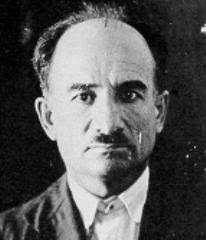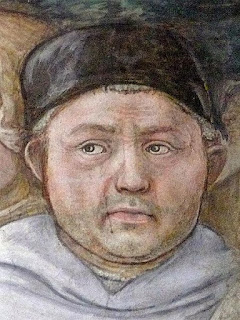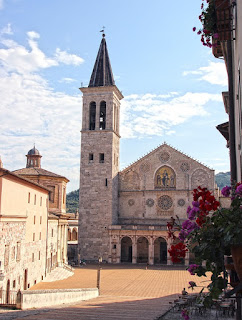Prime suspect in Wall Street bombing
Mario Buda, the anarchist suspected but never convicted of the 1920 Wall Street bombing, was born on this day in 1884 in Savignano sul Rubicone, a town in the Emilia-Romagna region, about 90km (56 miles) southeast of Bologna.
Mario Buda was suspected of being involved
with several bombings in the United States
Some 38 people were killed, with hundreds more injured, when a horse-drawn cart packed with explosives exploded close to the New York Stock Exchange building on the famous thoroughfare. Buda was identified by a blacksmith who had rented him the horse and Federal agents began an investigation.
The Italian, who had emigrated to the United States in 1907, was known to the police after being arrested previously in connection with a double-murder in the town of Braintree, Massachusetts. He had escaped from custody on that occasion and evaded detection again, boarding a ship to return to Italy before he could be questioned over the bombing.
Born into a family of modest means, Buda led an unsettled youth. He was arrested for robbery at the age of 15 and later served a jail term after being indicted on a charge of noise pollution at night. On his release, he was apprenticed to a shoemaker but remained restless and, like many young Italians in the early 20th century, imagined that moving to America would lead to a more prosperous life.
This proved far from the case. He flitted from one menial job to another amid a climate in New York that was hostile towards immigrants, particularly Italians, who were the victims of racial prejudice. In 1911, he went back to Italy but, finding his life chances no better than before, decided to make another attempt to settle in the US two years later, this time in Boston, a city with links in the community to Romagna, where he worked in a shoe factory.
 |
| Nicola Sacco (left) and Bartolomeo Vanzetti were key figures in the anarchist movement in Boston |
He began to attend anarchist meetings and to follow Luigi Galleani, a powerful orator and advocate of anarchist action, who edited a newspaper, Cronaca Sovversiva - Subversive Chronicle - which had 5,000 subscribers before the US Government closed it down in 1918.
In 1916, Buda was arrested for taking part in a demonstration in Boston against American intervention in World War One and sentenced to five months in jail after refusing to swear an oath on the Bible at his trial. On his release, he fled to Mexico with Sacco and Vanzetti to avoid being conscripted.
He was suspected of being a participant in a number of bombings, including an attack on a parade in San Francisco supporting US involvement in WW1 that killed 10 people, and another in Milwaukee, where a bomb placed outside an Italian Evangelical Mission was removed but then exploded inside a police station, killing nine officers and two civilians. Soon afterwards, a series of further bombings prompted the US Government to draw up the Immigration Act of 1918, which provided the powers for foreigners to be deported even on the basis of mere suspicion of subversive activity.
 |
| The 1920 Wall Street attack killed 38 people and wounded hundreds more |
Whether the Wall Street bomb was his work was never proved, although clearly someone had the motive to leave the horse-drawn wagon and its deadly cargo - some 100lb of dynamite and 500lb of cast-iron sash window weights - between the Stock Exchange building and the headquarters of J P Morgan, with a timing device that caused it to detonate at just after noon on 16 September. Among those who were injured but survived were Junius Spencer Morgan III, the son of J P Morgan, and Joseph P Kennedy, the father of future US president John F Kennedy.
Despite the testimony of the blacksmith, Buda was able to travel to the state of Rhode Island, the tiny state that neighbours Massachusetts and Connecticut, obtaining a passport from the Italian consulate. In October, he left New York on a French ship bound for Naples and by November was back in Savignano, where he resumed his aborted career as a shoemaker.
He kept a low profile initially but again was drawn towards anarchist causes. Arrested during clashes between fascists and anti-fascists in 1921, he was accused along with 15 others of being complicit in the murder of a police sergeant but was acquitted through lack of evidence. However, in August of the following year, a raid on his home turned up letters from anarchists in America and Italy and he was tried and convicted on conspiracy charges. He was imprisoned on the island of Lipari, where he became reacquainted with Galleani, a fellow prisoner, and then Ponza, before being released in 1932.
After initially moving to Switzerland, he returned to Savignano, where he had a relatively quiet life thereafter, continuing to make shoes. He died in 1963 at the age of 78, having allegedly admitted to a nephew in 1955 that he was responsible for the Wall Street bomb.
Travel tip:
The pretty harbour in the town of Lipari on the
island of the same name in the Aeolian Islands
With a population of approximately 10,000, Lipari is the largest of the Aeolian Islands, a volcanic archipelago off the coast of Sicily. The town of Lipari has picturesque streets reminiscent of Capri, with plenty of bars and restaurants, plus a pretty harbour and an historic castle. It can be reached by a ferry from Milazzo, on the northeastern coast of Sicily, the journey taking just under an hour, while local boat services link Lipari with the other islands, such as Stromboli, Vulcano and Salina. Although Lipari has volcanic origins, it is around 1,400 years since the last eruption, with volcanic activity today limited to thermal springs and fumaroles.
Travel tip:![]()
The Roman bridge across the waterway reputed
to be the historical Rubicon river
Savignano sul Rubicone, where Buda was born and died, is a town of some 16,000 inhabitants in the province of Forlì-Cesena, about 30km (19 miles) southeast of Forlì. It takes its name from the Rubicon, the river famous for Julius Caesar's historic crossing, when he led the army of Cisalpine Gaul, of which he was governor, across the river into territory controlled directly from Rome, thus sparking a civil war. For centuries the exact location of the original river was unknown, but in 1991, the Fiumicino, a river which passes through Savignano, was identified as the most likely location. Prior to that the town was called Savignano di Romagna. Along Via Matteotti in the town there is a bridge over the river said to date back to Roman times, marked with a statue of Julius Caesar.
Also on this day:
54: The death of the Roman emperor Claudius
1815: The execution of Joachim Murat, former King of Naples
1899: The birth of racing driver and car-maker Piero Dusio





















.png)